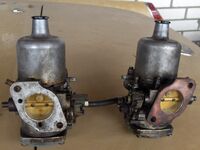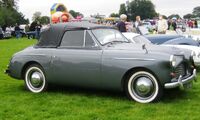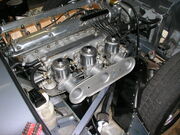
A pair of SU carburetters from an MGB.

The Austin A40 Sports, ca 1951, employed Twin SU Carburetters to achieve 46 bhp (34 kW) rather than 42 bhp (31 kW)[1] for the normally single-carbureted Austin A40[1]
SU Carburetters (named for Skinners Union, the company that produced them) were a brand of carburetter usually of the sidedraught type but downdraught variants were used on some pre-war cars.
They were widely used in British (Austin, Morris, Jaguar, Triumph, MG) and Swedish (Volvo, Saab 99) automobiles for much of the twentieth century. Originally designed and patented by George Herbert Skinner in 1905, they remained on production cars through to 1995 in the Mini and the Maestro by which time they had become part of the Rover Group. They are now manufactured by Burlen Fuel Systems Limited mainly for the classic car market. Hitachi also built carburetters based on the SU design which were used on the Datsun 240Z, Datsun 260Z and other Datsun Cars. While these appear the same, they differ to the extent that needles (see below) are the only part that fits both.
Operating principle[]
SU carburettors featured a variable venturi controlled by a piston. This piston has a tapered, conical metering rod (usually referred to as a "needle") that fits inside an orifice ("jet") which admits fuel into the airstream passing through the carburettor. Since the needle is tapered, as it rises and falls it opens and closes the opening in the jet, regulating the passage of fuel, so the movement of the piston controls the amount of fuel delivered, depending on engine demand.
The flow of air through the venturi creates a reduced static pressure in the venturi. This pressure drop is communicated to the upper side of the piston via an air passage. The underside of the piston is open to atmospheric pressure. The difference in pressure between the two sides of the piston lifts the piston. Opposing this are the weight of the piston and the force of a spring that is compressed by the piston rising. Because the spring is operating over a very small part of its possible range of extension, its force is approximately constant. Under steady state conditions the upwards and downwards forces on the piston are equal and opposite, and the piston does not move.
If the airflow into the engine is increased - by opening the throttle plate (usually referred to as the "butterfly"), or by allowing the engine revs to rise with the throttle plate at a constant setting - the pressure drop in the venturi increases, the pressure above the piston falls, and the piston is sucked upwards, increasing the size of the venturi, until the pressure drop in the venturi returns to its nominal level. Similarly if the airflow into the engine is reduced, the piston will fall. The result is that the pressure drop in the venturi remains the same regardless of the speed of the airflow - hence the name "constant depression" for carburettors operating on this principle - but the piston rises and falls according to the speed of the airflow.
Since the position of the piston controls the position of the needle in the jet and thus the open area of the jet, while the depression in the venturi sucking fuel out of the jet remains constant, the rate of fuel delivery is always a definite function of the rate of air delivery. The precise nature of the function is determined by the profile of the needle. With appropriate selection of the needle, the fuel delivery can be matched much more closely to the demands of the engine than is possible with the more common fixed-venturi carburettor, an inherently inaccurate device whose design must incorporate many complex fudges to obtain usable accuracy of fuelling. The well-controlled conditions under which the jet is operating also make it possible to obtain good and consistent atomisation of the fuel under all operating conditions.
This self-adjusting nature makes the selection of the maximum venturi diameter (colloquially, but inaccurately, referred to as "choke size") much less critical than with a fixed-venturi carburettor. To prevent erratic and sudden movements of the piston it is damped by light oil in a dashpot, which requires periodic replenishment. The dampening is asymmetrical: it heavily resists upwards movement of the piston. This serves as the equivalent of an "accelerator pump" on traditional carburettors by temporarily increasing the speed of air through the venturi, thus increasing the richness of the mixture.
The beauty of the SU lies in its simplicity and lack of multiple jets and ease of adjustment. Adjustment is accomplished by altering the starting position of the jet relative to the needle on a fine screw. At first sight, the principle appears to bear a similarity to that of the slide carburettor, which was previously used on many motorcycles. The slide carburettor has the same piston and main needle as an SU carburettor, however the piston/needle position is directly actuated by a physical connection to the throttle cable rather than indirectly by venturi airflow as with an SU carburettor. This piston actuation difference is the significant distinction between a slide and an SU carburettor. The piston in a slide carburettor is controlled by the operator's demands rather than the demands of the engine. This means that the metering of the fuel can be inaccurate unless the vehicle is travelling at a constant speed at a constant throttle setting - conditions rarely encountered except on motorways. This inaccuracy results in fuel waste, particularly as the carburettor must be set slightly rich to avoid a lean condition (which can cause engine damage). For this reason Japanese motorcycle manufacturers ceased to fit slide carbs and substituted constant-depression carbs, which are essentially miniature SUs. It is also possible - indeed, easy - to retrofit an SU carburettor to a bike that was originally manufactured with a slide carburettor, and obtain improved fuel economy and more tractable low-speed behaviour.
One of the downsides of the constant depression carburettor is in high performance applications. Since it relies on restricting air flow in order to produce enrichment during acceleration, the throttle response lacks punch. By contrast, the fixed choke design adds extra fuel under these conditions using its accelerator pump.
SU carburettor types[]

An SU fitted to an MZ in place of the original BVF slide carb

Three 2-inch SU HD8 carburetors as installed on an E-type Jaguar
SU Carburetters were supplied in several throat sizes in both Imperial (inch) and metric (millimeter) measurement.
The carburetor identification is made by letter prefix which indicates the float type:
"H": in which the float bowl has an arm cast into its base, which mounts to the bottom of the carburetor with a hollow bolt or banjo fitting. Fuel passes through the arm into the carburetor body. The bolt attaches to the carburetor body just behind the main jet assembly.
"HD": the float bowl mounts with its arm fastening directly below, and concentric with, the main jet. The arm has a flange that fastens with 4 screws to the bottom of the carburetor, and sealed with a rubber diaphragm integral with the main jet.
"HS": the float bowl is rigidly mounted to the carburetor body, but fuel is transferred by a separate external flexible line.
"HIF": the float bowl is horizontal and integral (hence the name).
"HV", "OM" and "KIF" types also exist but were less commonly employed.[2]
The Imperial sizes include 1-1/8", 1-1/4", 1-1/2", 1-3/4", 1-7/8", and 2", although not every type (H, HD, HS, HIF) was offered in every size.
There were also H models made in 2-1/4" and 2-1/2", now obsolete. Special purpose-built carburetors (Norman) were made as large as 3".
To determine the throat size from the serial number: If the final number (after one, two or three letters, beginning with H) has 1 digit, multiply this number by 1/8", then add 1". For example, if the serial number is HS6, the final number is 6: 6/8 = 3/4", add 1, total is 1-3/4", etc.
If the final number has 2 digits, it is the throat size in mm. For example, if the serial number is HIF38, the final number is 38, size is 38 mm etc.
See also[]
References[]
As of this edit, this article uses content from PESWiki, a source licensed under the terms of the GNU Free Documentation License which was imported into Wikipedia before November 2008 and is therefore validly licensed for use on Wikipedia. All relevant terms must be followed. The original article was at "PowerPedia:Carburetor".
- ↑ 1.0 1.1 Robson, G. (2006). A-Z of British Cars 1945-80. Devon, UK: Herridge. ISBN 0-9541063-9-3.
- ↑ Other types
External links[]
- Burlen Fuel Systems - manufacturer of genuine SU carburettors
- Guide to setting up and tuning SU carburettors
- Classic Motorsports magazine's guide to understanding, tuning and rebuilding SUs
| |||||||||||||||||||||||||||||||||||
| ||||||||||||||||||||||||||||||||||||||||||||||||||
| This page uses some content from Wikipedia. The original article was at SU carburettor. The list of authors can be seen in the page history. As with Tractor & Construction Plant Wiki, the text of Wikipedia is available under the Creative Commons by Attribution License and/or GNU Free Documentation License. Please check page history for when the original article was copied to Wikia |